Legendary X-Men writer Chris Claremont has a real knack for murdering heroes. From The Phoenix Saga to Muir Island, he knows how to time and execute major cataclysms only to use the resulting vacuum as a space for new characters to step in. And that’s exactly how the New Mutants team begins. It’s right there in the title: “The X-Men have seemingly been killed by The Brood, so here are some New Mutants.“
But anyone can just wipe out characters. What makes Claremont so special is that he never replaced anything. Again, it’s in the title: this isn’t just “more X-Men.” And in so many ways, this series truly was/is something new… even as it says “goodbye.”
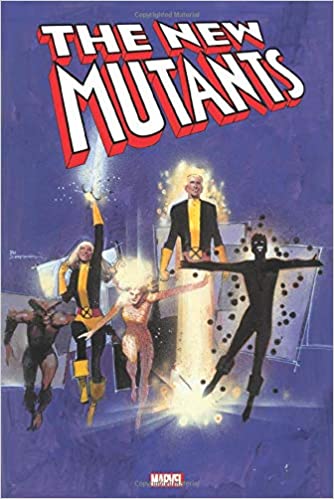 New Mutants Omnibus Vol. 1 | Overview
New Mutants Omnibus Vol. 1 | Overview
STORY SUMMARY
The Xavier Institute has a new student body; a next generation of mutants with strange powers. This 1980s classic follows a ragtag bunch of teens as they fight posh immortals, The Man, giant robots, space bugs, and one bear. But can these awesome teens do all of that and save their school? And the mall?! Find out December, when this class is very in. [Close on Vacation by the Go-Go’s]
Principal Artists
Chris Claremont, Bob McLeod, Sal Buscema, and Bill Sienkiewicz.
Collecting
NEW MUTANTS: RENEWAL (MARVEL GRAPHIC NOVEL (1982) 4); NEW MUTANTS (1983) 1-34; NEW MUTANTS ANNUAL (1984) 1; MARVEL TEAM-UP (1972) 100 (A STORY), 149; MARVEL TEAM-UP ANNUAL (1976) 6; UNCANNY X-MEN (1981) 160, 167, 180, 189, 192; MAGIK (1983) 1-4
Hardcover
1272 Pages
THE 80s EXPLAINED… SORTA
The 1980s were a long time ago. So long, in fact, that some of you might not have been there. This means someone screwed up and now I have to explain it to you. Which is a problem, because it doesn’t make any sense, even to those of us who were cursed to live in it. But it has to, if this article has any hope of coherence.
So let’s keep this simple. In terms of storytelling, the 80s had two modes. And both involved killing its children.
Death by Cop
 Like all classic dramas, this formula has three parts.
Like all classic dramas, this formula has three parts.
- Young characters take on adult roles while their parents become helpless children
- The youngsters shoulder increasingly ridiculous levels of responsibility
- Only to eventually have (other) adults point guns at them
Honestly, it’s wild how many “family classics” of the ’80s feature this trope. Legendary director Steven Spielberg is principally to blame.
The Goonies (1985) is a story of people losing their jobs, kids taking over economic responsibility for the household, and ultimately, everyone getting accosted by armed police. After that, Spielberg sold 120 million tickets to film about the government attempting to kill an 11-year-old, his friend, and their flying bike. Plus, a lot of kids die in Jaws.
I know Jaws himself isn’t police, but he does kill a lot of kids. Sharks are basically the narcs of the sea, and the rest of the film is about a sheriff trying to reclaim his jurisdiction over the ocean. The ending is very specific about this.
The Tennis Sweater Garrote
On the other side, you have Johns Hughes, who went for the less shooty, more suburban, middle America representation of teens. His films 16 Candles and Pretty In Pink — which is actually just one movie with two title cards — did something a little different by trying to make teenagers into actual characters.
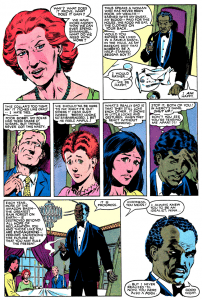
And then murdering them on the inside. With casual bigotry.
I know that really sounds familiar, but Modern English is on the soundtrack to make you forget (and make Hughes seem cool).
Similarities Between the Two
These two men saw that the America of the 1950s was slipping away from them, along with their youth. Like much of the rest of the country, they reacted by holding the next generation hostage and demanding their childhoods back.
One gets the idea that Hughes was very upset he couldn’t kill James Dean himself. I’ll bet that immediately after Hughes passed, one of his best friends rushed to his house to throw out his collection of laminated Ford Tudor catalogs.
I’m sorry, I was saying something about Chris Claremont, but it escapes me.
The Writing
PART ONE | The Classics Perfected
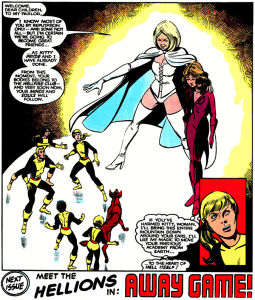
All of that 1980’s style and background becomes important in the original graphic novel and first seven issues of New Mutants. Most of it, anyway. Arguably some. In fact, everything before the Magik mini-series is essentially a Spielberg/Hughes mix of delighting in a model of comics as it disappeared, only it is a little too self-aware to be so nostalgic.
We’ll get into more detail soon, but the big things to watch out for is the way it treats its young heroes and the enemies set against them, as well as how the book plays with the idea of “a family-friendly classic.”
Overall, this phase in New Mutants is incredibly clever about how it toys with the idea of things being brighter in the past.
PART TWO | The Future Ahead
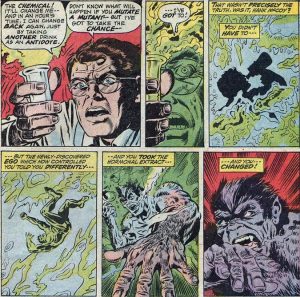 Which brings us to the second half, which comes at the start of “the dark age” of comics. That moniker is useless for a number of reasons (not the least of which being that the “hopeful” Golden Age is made up entirely of orphans), but it’s extra silly here because the X-Men brand has never not been in a “dark age.” True, there are exceptions. Aaron’s Wolverine and the X-Men for one, Milligan’s X-Statix for another. Plus there’s that article CBH did on Excalibur…
Which brings us to the second half, which comes at the start of “the dark age” of comics. That moniker is useless for a number of reasons (not the least of which being that the “hopeful” Golden Age is made up entirely of orphans), but it’s extra silly here because the X-Men brand has never not been in a “dark age.” True, there are exceptions. Aaron’s Wolverine and the X-Men for one, Milligan’s X-Statix for another. Plus there’s that article CBH did on Excalibur…
Still, for each of those highlights, there is at least one story about Charles Xavier losing the ability to walk, or ruining someone’s life, or both at the same time. There’s also the fact that every potential future for the team involves being murdered by some manner of robot.
The truth is, the X-Men’s “dark period” begins well before New Mutants, with issue 11 of Amazing Adventures, a comic that comes from a timeline so dark that X-Men had been canceled. Hank McCoy loses his job at the school, and so he’s forced to get a terrible corporate gig. Which, you guessed it, lead to him performing experiments on himself until he becomes a fuzzy monster.
For me, any dark age for the X-Men’s begins there. In this body horror within a body horror, a brilliant mind becomes trapped by irony inside an animal shape. A mutant transforming into a mutant. That pattern repeats throughout the series – Angel becoming Archangel, Logan becoming Weapon X, and so on.
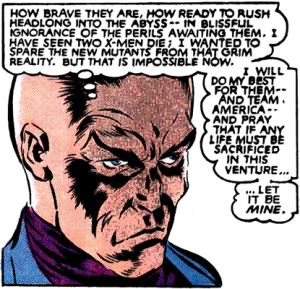 What’s fascinating here is how New Mutants goes for the same over-all effect using only its women. Rahne the hunted, Dani the shunned, Tran the hurt. From there, Magma and Magik join the team for their second year, bringing with them a moody, fantastic element that helps set the stage for what’s to come.
What’s fascinating here is how New Mutants goes for the same over-all effect using only its women. Rahne the hunted, Dani the shunned, Tran the hurt. From there, Magma and Magik join the team for their second year, bringing with them a moody, fantastic element that helps set the stage for what’s to come.
Those characters wind up being the strongest, and with them, we come to learn something important about the struggles we have, where things end, and where they begin.
The Art
The two parts are also aesthetically different, yet show some of the best work of their ages. Sal Buscema handles most of the front half, his adventurous style matching the tone in those issues. He also manages the baton hand-off with Magik mini-series and its grim downturn, which helps establish things so Sienkiewicz doesn’t go in cold.
The great thing about the omnibus format is how it clarifies with context. How it shows the fun and the fear of things, but also how these stories work overtime. Bill’s work is distinctive, but he doesn’t usher in some dark age; rather an unimagined future. The writing makes that move with him.
I have more to say about both below, but this neat partitioning feels fantastic when collected side by side-and-really gives an appreciation for just what this book was doing.
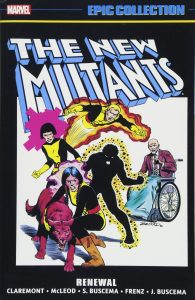 New Mutants: Renewal (OGN)
New Mutants: Renewal (OGN)
Author: Chris Claremont
Pencils and Inks: Bob McLeod
Color: Glynis Wein
Letters: Tom Orzechowski
If the New Mutants were to be a new kind of X-Men, then Renewal was their ignition. Here, Claremont restarts the X-Men out of order, beginning with Len Wein’s Giant-Sized X-Men format. Renewal’s adoption of the graphic novel format is just an update of GS#1’s massive page count. Just as before, a literally bigger book makes for a figuratively bigger story, allowing us to go global and establish a similarly international team. New Mutants does this by moving from Scotland to Brazil and beyond to establish a full world and fuller characters.
Then, Claremont seems to return to the original Lee/Kirby template, and updates it for the time.
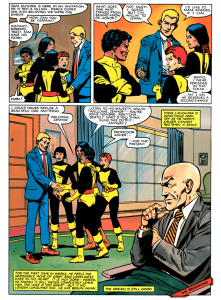 NEW SCHOOL
NEW SCHOOL
That first graduating class of the Xavier Institute for Gifted Youngsters was… limited. Even taking into account 60s Marvel’s collegiate obsession, Lee and Kirby’s X-Men was way too reflective of that society’s views on higher education and aptitude. The first X-Men team is 80% male, 100% white, and each of them held a degree from a private school in Massachusetts. And worst of all, they felt like it.
New Mutants goes from that Ivy League 80/100, to a 60/80 split the other way. More women meant no more creepy “Jean Grey, teacher’s pet” nonsense. The series also nixes the quarterback, theater jock, hotheaded prankster, and name-with-a-number-after-it archetypes. It even does away with the tired idea of Charles Xavier wanting child soldiers.
In their place comes a more complicated bunch. Cannonball, the oldest, is sort of the older brother of the team. Wolfsbane, the youngest, is the eager and earnest kid sister. Between them, you have Sunspot, the middle sibling with something to prove, Psyche, the sister secretly raising them, and Karma, the peacemaker.
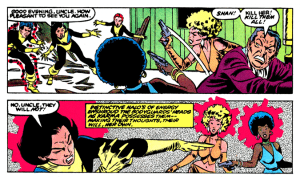
ON THE IMPORTANCE OF POWERS
It’s also fascinating how different this new teams’ powers are to those of the O5. The New Mutants lack the distance attacks of the original team, like eye beams, ice, telekinetic group shields, and simplified communication through telepathy.
All of which is to say, they mostly lack passive options. The New Mutants are built for hand-to-hand confrontation. Their combined power set requires direct confrontation, tighter teamwork, and yet still leaves them more vulnerable.
Between the changes in demographics and strategy, New Mutants makes for a more interesting team. At least initially.
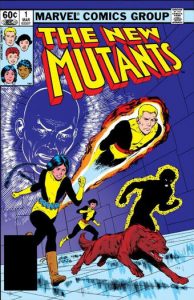 The Beginning | New Mutants 1-7
The Beginning | New Mutants 1-7
Author: Chris Claremont
Pencils: Bob McLeod (1-3, Sal Buscema (4-7)
Inks: Armando Gil, Mike Gustovich. Bob McLeod, John Tartaglione
Color: George Roussos, Glynis Wein
Letters: Janice “The Indomitable” Chiang, Tom Orzechowski
Above, we discussed how ’80s media was seemingly hostile towards kids. The decade produces story after story in an apparent attempt to crystallize this, and to perfect the kind of villain — be it heartless industrialist or simple beat cop or even James Spader — who would be evil enough to do what the audience secretly wants to see and murder America’s future.
Which the decade needn’t have done, because New Mutants nails this.
Meet Henry Peter Gyrich. This half-human, half-Windsor hybrid is the Director of the National Security Council and a man “answerable only to the President.” This makes him the highest-ranking narc in this or any other government.
And his mission — his only mission — is to stop a group of children at a mall.
This is the apotheosis of the 1980s. It is, it imperially is. The agony and the ecstasy of the perfect mixtape. The affordable future inside of every Arcade. The inspiring determination of Kerri Strug returning perfectly to earth. All of that can get stuffed.
Look at this Robert Redford looking fool, with his standard-issue haircut and that suit he stole off an ice cream man. Look at him, worrying about the boilerplate red menace like he’s not wearing his sunglasses indoors. Henry Peter Gyrich uses all three of his names and talks in the third person, and I say we need more of this clown.
‘What was the plan? Was any of this the plan? How much did it cost? These and other questions are told to wait in the car, because this whole first half is one, glorious celebration to military over-budgeting and under-planning. And my only regret is that New Mutants doesn’t have 30 more volumes of “paying billions of dollars on unjustifiable confidence.”
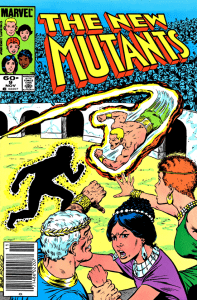
Circus Maximus | New Mutants 8-13
Author: Claremont
Pencils: Buscema
Inks: Tom Mandrake, McLeod
Color: Wein
Letters: Orzechowski
There comes an important point in every series where a team must add a new member. And I’m going to cut to the chase a bit: this is another fantastic genre-aware choice on the part of editor Louise Jones/Simonson, Claremont, and the rest of the team.
Top to bottom, issues 8-13 feels like OG Star Trek. This stretch of issues feels like Marvel had some old backdrops and costumes hanging around so, for budgetary reasons, the “alien planet” looks like ancient Rome.
Everything about this arc is straight out of the goofy, gloriously half-assed mold of that era. The team wears senatorial robes, there’s an arena fight, and somehow Sunspot knows pre-Vatican Latin. A fact that never comes up or in handy again. To make it all perfect, Rahne is thought to be the Capitoline Wolf, the beast that reared Romulus and Remus.
I cared much more for this story than the new character it introduces. Amara Aquilla (aka Magma) just kind of exists. The comic is more about Buscema’s gladiators and amphitheaters and Claremont’s horsing around, which means Aquilla quickly feels forgotten. By issue 12, she just feels obligatory as she takes her undeniable heel-turn, destroys much of a city, and is saved through the power of friendship. Way less fun than a toga party.
I feel the same way about Emma Frost’s Hellions. They’re a classic Mirror, Mirror set up (see issue #15). The choice to build a team of teenagers to fight another team of teenagers is that same kind of wonderful comic book nonsense logic that I love about this era. As a concept, it is delightful, but as characters, the Hellions are instantly forgettable. Or at least this appearance of them is. Just as their big surprise — Kitty Pryde being forced into evil (I have spoiled nothing) — feels every bit as obligatory as that lava girl I was just talking about.
Sal Buscema
The artwork in this half of the series is just spectacular and is so beautifully informed by Sal’s days on pulps like Tarzan and Conan. Every splash is a masterpiece, every sequence an adventure.
The Perfect Way to Go
There are impossible things that we all simply believe are true. Take the unique logic of holiday stories. We spend the year fighting to survive only to agree that, for a few days, we’ll all give with infinite generosity. We’ll go from never getting what we want to total unironic wish fulfillment. Those we’ve lost will return, and all our wants will be taken away.
So of course the X-Men return from the dead on Christmas. They show up unannounced and unburdened by rumors of their demise. This is an agreed-upon miracle, one you can set your watch to, and it’s that classic magical thinking that makes this such a sweet close to the first half of New Mutants.
It’s the dreamlike unreality of this that makes it the perfect setup for what’s to come. We agree that, on certain days, the impossible is part of the plan. Let’s see what happens on a different day.
What I’m Happy Will Not Stay
I love classic Marvel heroes. Their stories are so full of wonder, adventure, and hope. It gives them a resilient strength.
But god am I ever sick of “classic Marvel humor.” It has something to do with the nostalgia in each joke and how this outlook clings to the “glory days” of Moxie Cola and everything being fundamentally a sock-hop. I also have reservations about superheroes being out of touch and how a mindset that says “things were better before” invalidates the whole job description of a superhero.
But my real problem, the thing that truly grits my teeth, is that this could all just stop. After Lee’s initial successes, and certainly after his tenure as editor, the company he helped create became obsessed with Stan, The Man. His concepts and process became downright Talmudic within the corporation. That approach exists to this day, creeping into issues of Spider-Man. But in New Mutants, it seems to mostly stop here, swept out by the supposed “dark age.” Sometimes I miss those Lee/Kirby stories and their forgotten concepts like “valor.” But I think comics are fundamentally better off without gags like these.
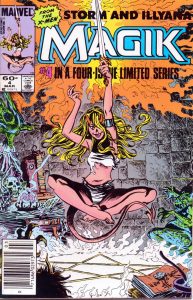 Road of Trials | Uncanny X-Men #160, Magik Limited Series and the End of an Epoch.
Road of Trials | Uncanny X-Men #160, Magik Limited Series and the End of an Epoch.
Uncanny X-Men #160 | “Chutes and Ladders”
Author: Claremont
Pencils: Brent Anderson
Inks: Bob Wiacek
Color: Wein
Letters: Orzechowski
Magik (Illyana and Storm) #1-4
Author: Claremont
Pencils: Buscema, Ron Frenz
Inks: McLeod, Tom Palmer
Color: Ken Feduniwicz, Wein
Letters: Orzechowski
In Chutes and Ladders, Illyana Rasputin is sucked into a portal to the Limbo realm, where the demon Belasco transforms her from Colossus’ baby sister Illyana into Magik, the teenage sorceress and demon goddess. The Magik limited series explores that time in Limbo and how what appeared instantaneous to the X-Men was in fact seven grueling years in hell for Illyana.
This origin was made with an older audience in mind, and I would not recommend it for kids. Don’t get me wrong, Claremont’s writing is as great as ever, but Magik is a hard swing tonally. This is a hard fantasy story, in line with the 80s RPG craze, and it’s absolutely jet-black at times (including showing one or two mutilated main characters).
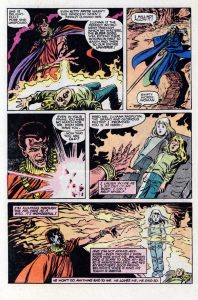 That said, Magik was a great character to add to New Mutants. Her experience with demons and the Limbo is a natural conflicting compliment to Psyche’s world of nightmares. Not to mention that Illyana’s hell-touched nature sparks wonderfully against Rahne’s whole “penitent Christian” thing. This friction between characters plays well in New Mutants #14 and onward.
That said, Magik was a great character to add to New Mutants. Her experience with demons and the Limbo is a natural conflicting compliment to Psyche’s world of nightmares. Not to mention that Illyana’s hell-touched nature sparks wonderfully against Rahne’s whole “penitent Christian” thing. This friction between characters plays well in New Mutants #14 and onward.
Magik, as a book, was a smart addition to the whole X-drama. New Mutants was meant to leap the X-franchise into the 80s, but the Magik mini-series is where it burns its boats. Though not quite entirely; it builds smartly off elements from God Loves, Man Kills, and Buscema’s pencils give the mini-series some connective tissue between the Marvel ’60s-’70s approach to comics and the ’80s.
Up until now, New Mutants is secretly not just the start of a new era of comics, but a kind of loving, final chapter of an old one. Because what comes after is almost a new animal entirely.
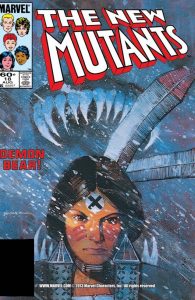 The Demon Bear Saga | New Mutants #18-20
The Demon Bear Saga | New Mutants #18-20
Author: Claremont
Pencils & Ink: Bill Sienkiewicz
Color: Wein
Letters: Orzechowski
So much has been said already about these three issues (some of it by me). While I love and revere this series to my very bones, it’s easy to get lost in the raw creativity of the book. In fact, I think that’s the point of this arc, but to do so runs the risk of talking about these three issues merely in terms of “more.”
I’m here to tell you something often overlooked. Some of the best parts of Demon Bear are where it’s doing less.
On the surface, this is still a big story. The long foreshadowed monster has finally come for Dani Moonstar and now her friends must step out of their world in order to save their friend in the dream world. At the same time, an unknown being is being chased across the cosmos towards the earth.
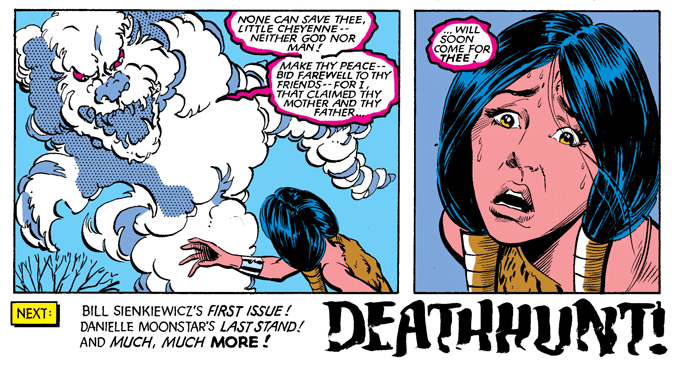
Claremont has a knack for purple prose.
Check out his work on Excalibur: The Sword is Drawn or Wolverine vol 1 to see what I mean. And while Claremont does sneak some things in (the parallels between Dani and Illyana seem clear, as does the recurring theme of two women’s powers reacting when in proximity) he never obstructs. His script is often tuned down to just the simple facts. Legend has it, this was at Sienkiewicz’s request, as it freed the artist up to go wild.
This brings us to Bill. His style is still fresh here, still as shocking and expressive as it was in “Hit It“ (Moon Knight #26). And his use of three distinct styles to represent the three worlds of the book (Wes Craven for the real world, Jasper Johns for Warlock’s tale, and Ralph Steadman for the Bear’s dream world.) Sienkiewicz balances the seemingly incompatible styles by focusing on how they exemplify the in-between state of one’s teen years: the aggressive adulthood of edgy media and the childish quality of dreaming.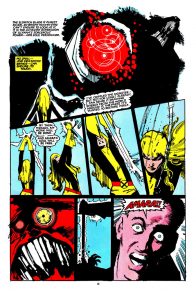
However, Sienkiewicz deserves far more credit for his restraint. See on this page from issue 20, where the Bear/fantasy aesthetic is stabbed by Illyana/photo-referenced realism. See how stylized the bear is, while Magik is simplified to simple lines and forms. Note how her face is picture-perfect with only a few shapes, where the bear is a wild, gestural scribble.
For all its wonder, the thing that most surprises me about this book is how unexpectedly controlled it can be.
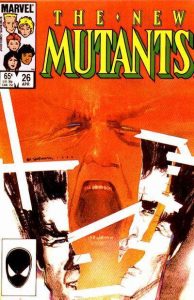 Dream World Eternal | New Mutants 21-32
Dream World Eternal | New Mutants 21-32
Author: Claremont
Pencils & Ink: Sienkiewicz, Steve Leialoha
Color: Wein
Letters: Lois Buhalis, Orzechowski, Joe Rosen
In New Mutants: Renewal and New Mutants #1-7, Claremont makes a series of direct, unobfuscated promises to the audience. Among them are:
- David Haller, the secret son of Charles Xavier, needs his father’s help
- Rahne Sinclair’s transformation power means she’ll have to pick one side or the other for the sake of her soul
- Danielle Moonstar is a child between this realm and another and she must fight the bear that threatens both
Each is an example of classic foreshadowing, but that technique doesn’t necessitate clarity. To me, the signposts had to be literal because each of the book’s revelations would be anything but.
This goes beyond Claremont and Sienkiewicz’s symbolism and aesthetics that define this era of the book. In New Mutants, things exist without end.
In this final arc, all the classic story beats come back around, just as the era’s explosion of media availability taught readers they would. Enemies return. The Colosseum, we find, has stayed. The dreaming wasteland never leaves.
(Though the majority of this series seems to take place on Muir Island, which was later Xavier Academy, Ireland. Which is maybe why I keep thinking of what Beckett said: “The end is in the beginning and yet you go on.”)
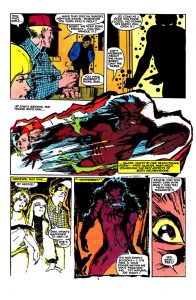
A LITTLE METAPHYSICS
Each of the characters in this story represents some contradiction in identity or personhood.
- Karma exists between two bodies
- Wolfsbane exists between two species
- Sunspot has two states of being, separated by a renewable power source
- Cannonball is a man cut in half, and only partly in control
- Psyche, Magik, Warlock, and Magma belong to two different worlds
- Legion’s one-and-many nature
We could talk in terms of the endless cycle of death and rebirth, or the perpetual quantum state of becoming. But neither of those are true. There is no transubstantiation. The story held in this omnibus is not about one thing becoming another.
Everything always is. This… this is its story.
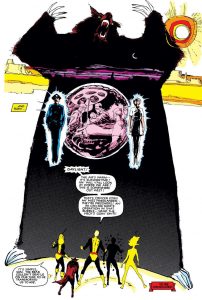 The Secret of Thomas Corsi and Sharon Friedlander
The Secret of Thomas Corsi and Sharon Friedlander
In issue 18, Corsi and Friedlander appear first as a pair of white adults. In the middle of the story, they seemingly disappear, killed, kidnapped, or perhaps rendered inert by the story’s monster In the end, the two reappear, only as Native Americans, in bodies that are impossibly strong. Yet, Corsi and Friedlander exist for all to see.
Here is the truth of it: The two never leave, and never change. For this to make sense, I have to tell you what you know.
In issue 18, you become aware of Thomas Corsi and Sharon Friedlander. Suddenly, they exist. And in doing so, they can’t un-exist. For the same reason, Haller’s past cannot be healed by Xavier’s present, and Sinclair cannot be a woman or a wolf, only both. It’s why Dani can neither stop the bear or sate her vengeance. It’s how the X-Men have died so many times, but never truly die.
We return to the secret of these two people. The idea of Thomas Corsi and Sharon Friedlander. What they are cannot be resurrected or reincarnated. They look different but only because we see them on different pages. But stop looking at the story and look at the book: the two disappear, yet the page count is unchanged. And so what constitutes “Thomas Coris and Sharon Friedlander” must persist not on pieces of paper, but in the ether between.
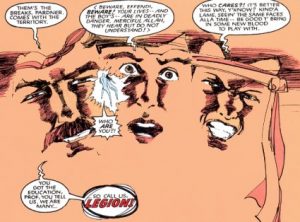 The Passion of David Haller
The Passion of David Haller
Corsi and Friedlander’s special nature is that Legion appears to them first. Legion is the secret child of Charles Xavier and Gabrielle Haller, and he exists as secrets exist. Ephemeral, ever-changing, but always a single thing.
Legion is one being comprised of many beings. In the past, some of those were unique with lives of their own, while others were fabrications. In the present, they are Legion. Yet the memories and personalities don’t end; each is still somehow a person.
It seems only natural that Legion would appear to Corsi and Friedlander first just by their sheer symmetry. I wonder if Thomas and Linda, along with David and his personalities like Cyndi, Jack Wayne, Jermail Karami, all occupy a single reality? The book seems to suggest so.
Final Thoughts | Russell’s Paradox
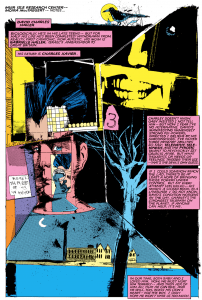 The book speaks in incredibly clear language, but that does not make its message any less difficult. Its places, events, and characters can be at odds with our perception of reality. Our world, like much of comics before, insists on a binary state: things either are or are not. Yet, each of the New Mutants refutes this by their very existence, as do their other homes, such as the desert of dreams, Limbo, or the astral plane. Even the peculiar time interruptions of Rome point to this.
The book speaks in incredibly clear language, but that does not make its message any less difficult. Its places, events, and characters can be at odds with our perception of reality. Our world, like much of comics before, insists on a binary state: things either are or are not. Yet, each of the New Mutants refutes this by their very existence, as do their other homes, such as the desert of dreams, Limbo, or the astral plane. Even the peculiar time interruptions of Rome point to this.
What we call “real” exists under the strictest observation, reinforced to death by dictionaries, euclidean geometry, and ten items or fewer lines. Teeth marks in the gold coin of the universe. Its limitations, our comforts.
This book reminds us that so little is binary. So much of what we know to be real does not fit neatly into “is” or “is not.” What are dreams, what is death, what is memory?
For that matter, where have Spielberg or Hughes’ childhoods gone? What are the borders of America’s future? Do things end and begin as comics do, or are they endless, unchanging, like our definition of heroism? All of the things that frighten us, can’t we just feed them to a giant shark?
If our world has boundaries and the shared space of thoughts, dreams, and the afterlife does not, then our lives, their careful measures, their laid plans — their beginnings and endings — must all exist within that endlessly shared space. Infinity must contain all things, including itself. Or put much more simply: There is a palpable difference between issues #1-17 and 18-32. There is something new in the tone of the narrative. There is a noticeable shift from one artist’s style to the next. But nothing has changed.
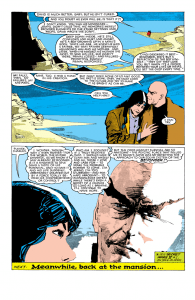 Sienkiewicz has so much fine art to his style, but his foundational anatomy toes the same line as Buscema’s. They both contain the holy trinity of Jack Kirby, Tex Avery, and Cinema. New Mutants Annual #1 revels in rock-opera just as issue #8 did with Rodenberry’s Rome. Even the stories don’t change. An alien has fallen from the sky, yet Rahne’s rural Irish priest returns to scream about the Heavens.
Sienkiewicz has so much fine art to his style, but his foundational anatomy toes the same line as Buscema’s. They both contain the holy trinity of Jack Kirby, Tex Avery, and Cinema. New Mutants Annual #1 revels in rock-opera just as issue #8 did with Rodenberry’s Rome. Even the stories don’t change. An alien has fallen from the sky, yet Rahne’s rural Irish priest returns to scream about the Heavens.
Issue one began with Gabrielle Haller keeping an enormous secret from her former lover, Charles Xavier. Here at the end, we see it all reversed. The two walk together on a beach, talking, against all odds, where the cold and pitiless ocean meets familiar, desolate sand. Their feet on the tidal plane, a place where every wave crashes and rolls back again. An impossible place that is neither earth nor sea, but always both. The infinite endlessly becoming the infinite.
The estranged couple are there, talking about their son and the certainty of his struggles. Yet, they are impossibly hopeful. David is the place where these two have crashed into one another and not rolled back. A boy that is both many people and one, a human liminal space, like this spot where an ocean meets a desert, where our dreams hold us and we become what we touch.
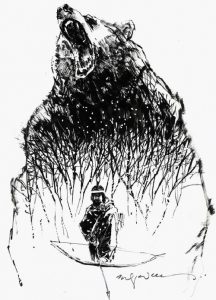 When the sands of the wasteland come, they are not death. They are always here, reminding us that everything is temporary, but all is eternal. That we exist in a world inside of a world so full of amazement that the two bleed through the seams, like a dream upon waking or reality fading into sleep. New Mutants is an endless apparition of this. The beautiful part about reality is that it’s bound principally by fantasy. This means reality is a world where nothing ever isn’t, and in that place, we are everyone we will ever be.
When the sands of the wasteland come, they are not death. They are always here, reminding us that everything is temporary, but all is eternal. That we exist in a world inside of a world so full of amazement that the two bleed through the seams, like a dream upon waking or reality fading into sleep. New Mutants is an endless apparition of this. The beautiful part about reality is that it’s bound principally by fantasy. This means reality is a world where nothing ever isn’t, and in that place, we are everyone we will ever be.
The X-Men were built on Charles Xavier’s dream. The New Mutants are built on a new one. One that sees the mistakes of the past without missing its value. One that runs recklessly into the future, even with all it could hold. It is the same dream, but different. Better. And I can think of nothing more hopeful than the idea of better dreams.

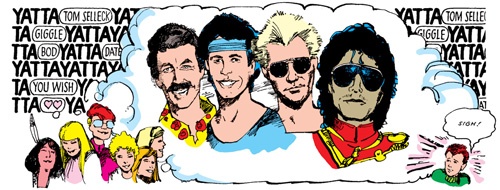

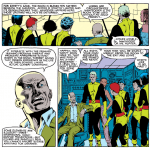
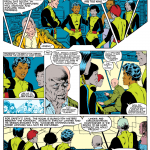
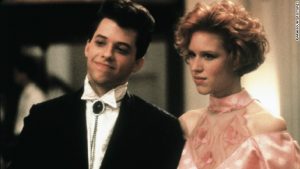
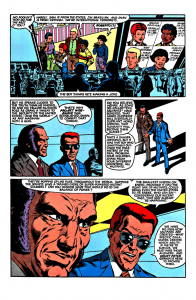
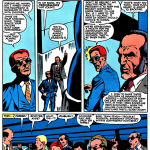
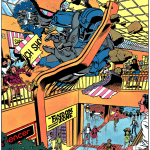
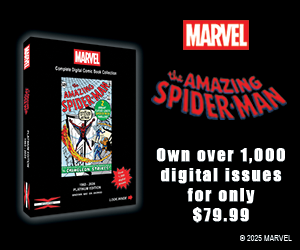
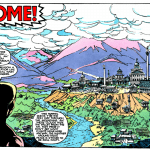
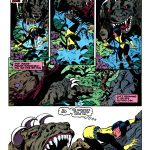
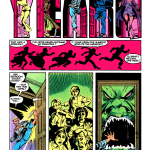
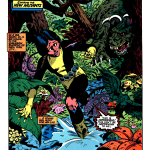
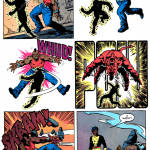
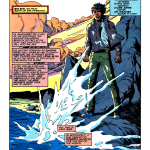
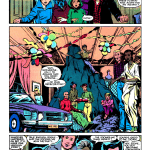
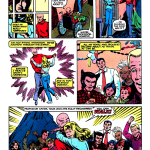
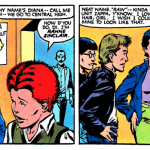
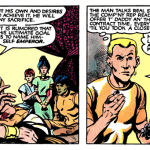
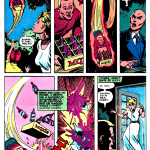
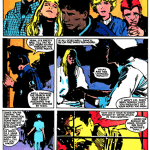
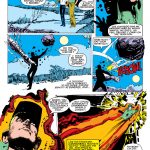
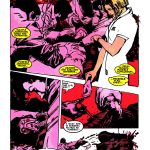
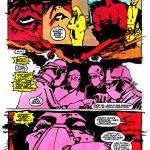
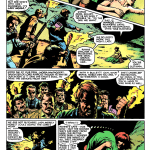
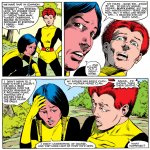
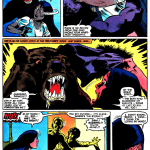
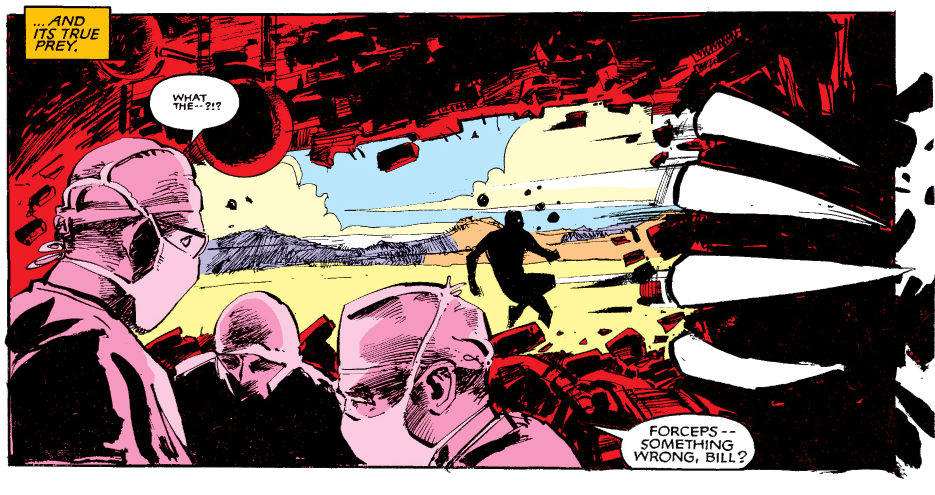
Leave a Reply